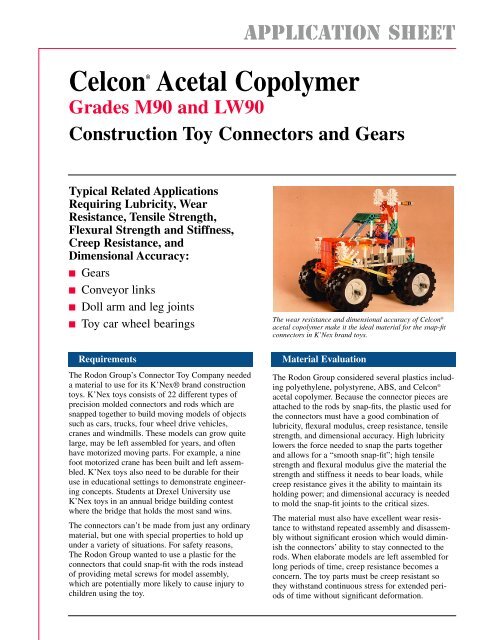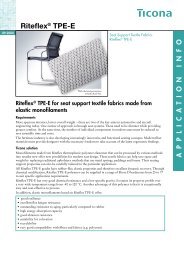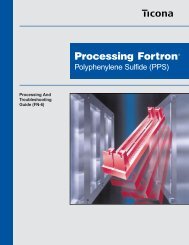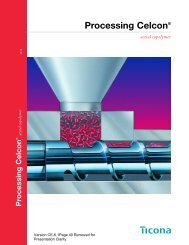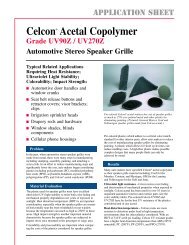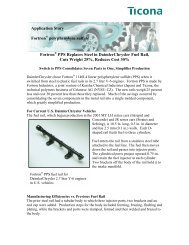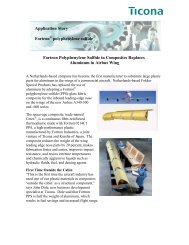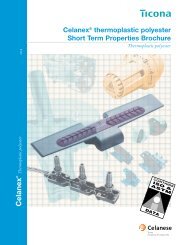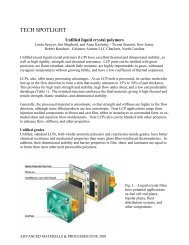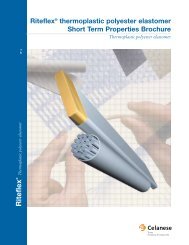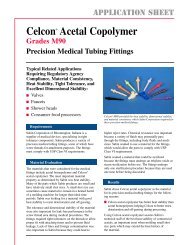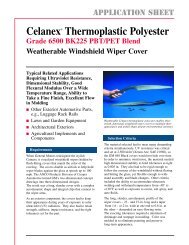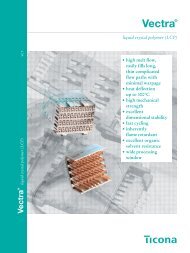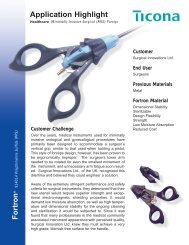Celcon POM M90 K'Nex Toys - Hi Polymers
Celcon POM M90 K'Nex Toys - Hi Polymers
Celcon POM M90 K'Nex Toys - Hi Polymers
Create successful ePaper yourself
Turn your PDF publications into a flip-book with our unique Google optimized e-Paper software.
APPLICATION SHEET<br />
<strong>Celcon</strong>® Acetal Copolymer<br />
Grades <strong>M90</strong> and LW90<br />
Construction Toy Connectors and Gears<br />
Typical Related Applications<br />
Requiring Lubricity, Wear<br />
Resistance, Tensile Strength,<br />
Flexural Strength and Stiffness,<br />
Creep Resistance, and<br />
Dimensional Accuracy:<br />
■ Gears<br />
■ Conveyor links<br />
■ Doll arm and leg joints<br />
■ Toy car wheel bearings<br />
Requirements<br />
The Rodon Group’s Connector Toy Company needed<br />
a material to use for its K’Nex® brand construction<br />
toys. K’Nex toys consists of 22 different types of<br />
precision molded connectors and rods which are<br />
snapped together to build moving models of objects<br />
such as cars, trucks, four wheel drive vehicles,<br />
cranes and windmills. These models can grow quite<br />
large, may be left assembled for years, and often<br />
have motorized moving parts. For example, a nine<br />
foot motorized crane has been built and left assembled.<br />
K’Nex toys also need to be durable for their<br />
use in educational settings to demonstrate engineering<br />
concepts. Students at Drexel University use<br />
K’Nex toys in an annual bridge building contest<br />
where the bridge that holds the most sand wins.<br />
The connectors can’t be made from just any ordinary<br />
material, but one with special properties to hold up<br />
under a variety of situations. For safety reasons,<br />
The Rodon Group wanted to use a plastic for the<br />
connectors that could snap-fit with the rods instead<br />
of providing metal screws for model assembly,<br />
which are potentially more likely to cause injury to<br />
children using the toy.<br />
The wear resistance and dimensional accuracy of <strong>Celcon</strong> ®<br />
acetal copolymer make it the ideal material for the snap-fit<br />
connectors in K’Nex brand toys.<br />
Material Evaluation<br />
The Rodon Group considered several plastics including<br />
polyethylene, polystyrene, ABS, and <strong>Celcon</strong> ®<br />
acetal copolymer. Because the connector pieces are<br />
attached to the rods by snap-fits, the plastic used for<br />
the connectors must have a good combination of<br />
lubricity, flexural modulus, creep resistance, tensile<br />
strength, and dimensional accuracy. <strong>Hi</strong>gh lubricity<br />
lowers the force needed to snap the parts together<br />
and allows for a “smooth snap-fit”; high tensile<br />
strength and flexural modulus give the material the<br />
strength and stiffness it needs to bear loads, while<br />
creep resistance gives it the ability to maintain its<br />
holding power; and dimensional accuracy is needed<br />
to mold the snap-fit joints to the critical sizes.<br />
The material must also have excellent wear resistance<br />
to withstand repeated assembly and disassembly<br />
without significant erosion which would diminish<br />
the connectors’ ability to stay connected to the<br />
rods. When elaborate models are left assembled for<br />
long periods of time, creep resistance becomes a<br />
concern. The toy parts must be creep resistant so<br />
they withstand continuous stress for extended periods<br />
of time without significant deformation.
Results<br />
The Rodon group chose <strong>Celcon</strong> acetal for the connectors<br />
of its K’Nex toys because it has the combination of<br />
properties that the toys require. <strong>Celcon</strong> acetal has a<br />
higher tensile strength than polyethylene, polystyrene,<br />
and ABS. The connectors made from <strong>Celcon</strong> acetal<br />
resist wear from repeated snap-fit assembly. Because<br />
<strong>Celcon</strong> <strong>M90</strong> has a flexural modulus of 375,000 psi, the<br />
models can be assembled through snap-fits and the connectors<br />
are stiff enough to hold the rods in place. The<br />
lubricity of <strong>Celcon</strong> acetal copolymer allows the parts to<br />
be assembled without much friction or wear.<br />
In order for the snap-fit joint to work properly, <strong>Celcon</strong><br />
acetal must consistently obtain the proper dimensions in<br />
molding. Under proper molding conditions, <strong>Celcon</strong><br />
acetal copolymer can hold a tolerance of ± 0.002 inch/<br />
inch on the first inch of part dimensions and ± 0.001<br />
inch/inch on subsequent dimensions.<br />
<strong>Celcon</strong> acetal resists creep, the deformation which is<br />
caused by long-term loading situations. After 1000 hours<br />
with greater than three times the load, <strong>Celcon</strong> acetal<br />
exhibits a creep modulus similar to ABS. This ability to<br />
withstand deformation under load assures continuous<br />
performance in snap-fits.<br />
Some sets of K’Nex toys include plastic gears which are<br />
used with motors to turn moving components. Rodon<br />
Group chose <strong>Celcon</strong> LW90, a wear resistant acetal<br />
copolymer, for these gears. Before selecting <strong>Celcon</strong><br />
LW90 resin, they tested nylon gears which lasted about a<br />
week in continuous use before showing significant wear.<br />
Gears made from low wear <strong>Celcon</strong> acetal lasted over a<br />
year in continuous use, or 52 times longer.<br />
If you are interested in obtaining a sample of <strong>Celcon</strong><br />
resins or would like to know how its wear resistance<br />
can help you increase your product quality or product<br />
life, please call Product Information Services at<br />
1-800-833-4882 and mention “Application Sheet 94-06”.<br />
Property <strong>Celcon</strong>® acetal Polyethylene ABS Polystyrene<br />
<strong>M90</strong> [LW90] (<strong>Hi</strong>gh impact) (<strong>Hi</strong>gh impact)<br />
Coefficient of friction 0.15 [0.10] n/a 0.3 0.28<br />
against steel<br />
Flexural stress @ 5% 13,000 [12,300] n/a n/a n/a<br />
deformation (psi)<br />
Flexural modulus (ksi) 375 [370] 145-225 179-375 160-390<br />
Tensile strength at yield (psi) 8800 [8500] 1650 2600-5900 2100-6000<br />
Flexural creep modulus (ksi) 220 [n/a] (5000 psi 22 (1250 psi 250 (1500 psi n/a<br />
1000 hours of loading initial loading) initial loading) initial loading)<br />
Taber abrasion (mg/1000 cycles) 6 [n/a] n/a n/a n/a<br />
1000g load, CS-17F wheel<br />
Ticona<br />
90 Morris Avenue<br />
Summit, New Jersey 07901-3914<br />
(908) 598-4000<br />
© 2000 Ticona<br />
Printed in U.S.A. AP94-06/4M/1200


